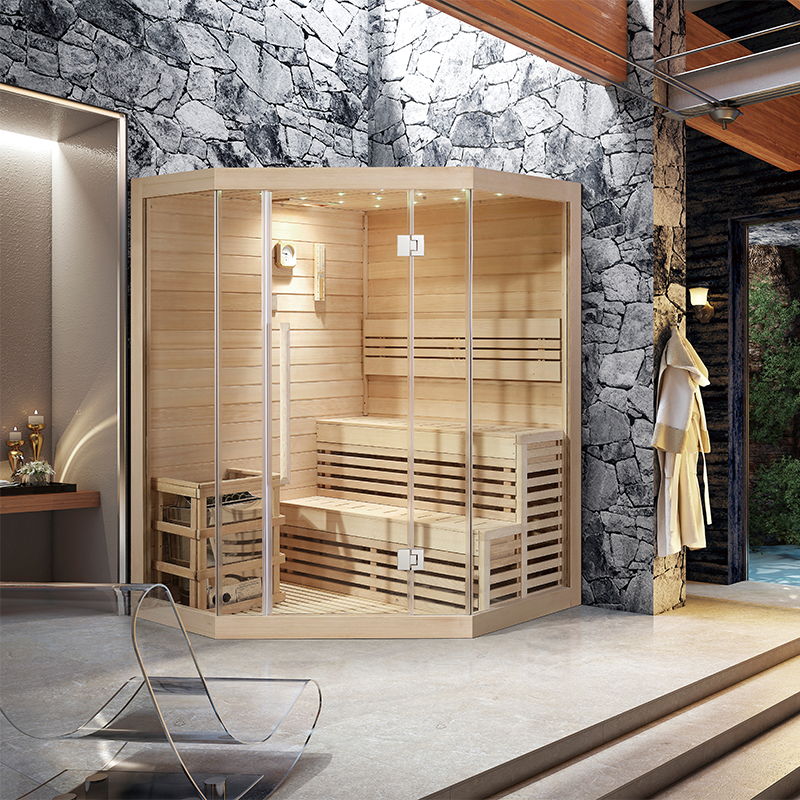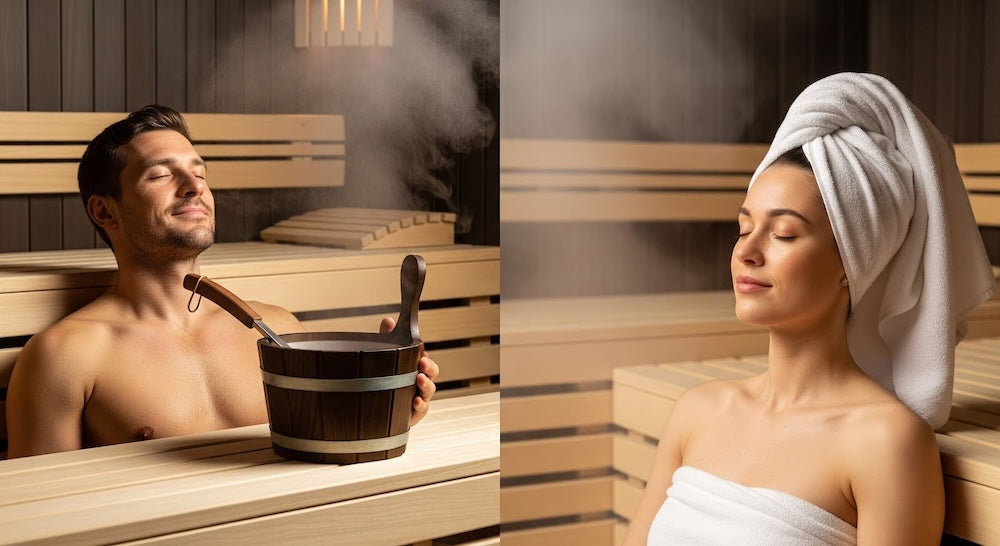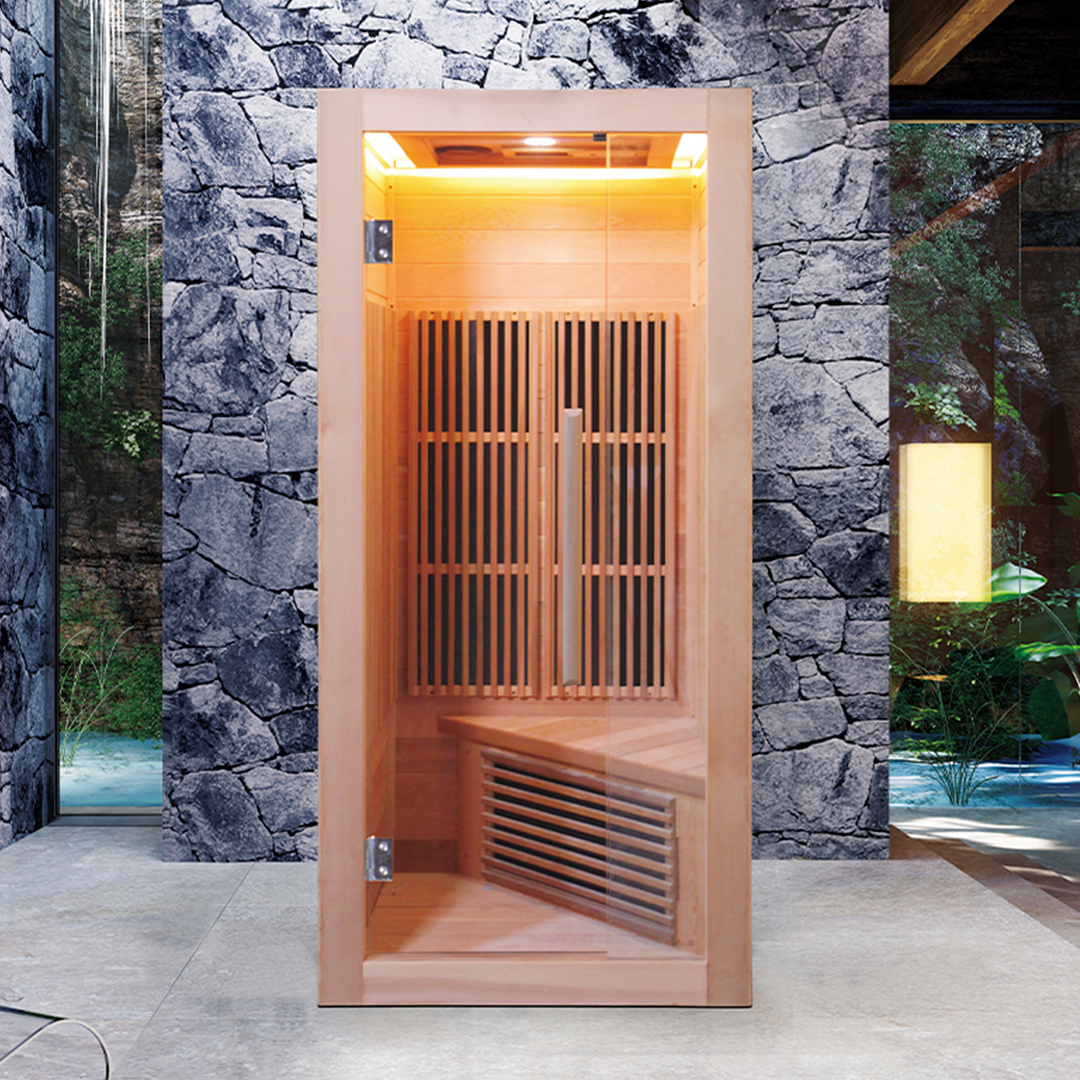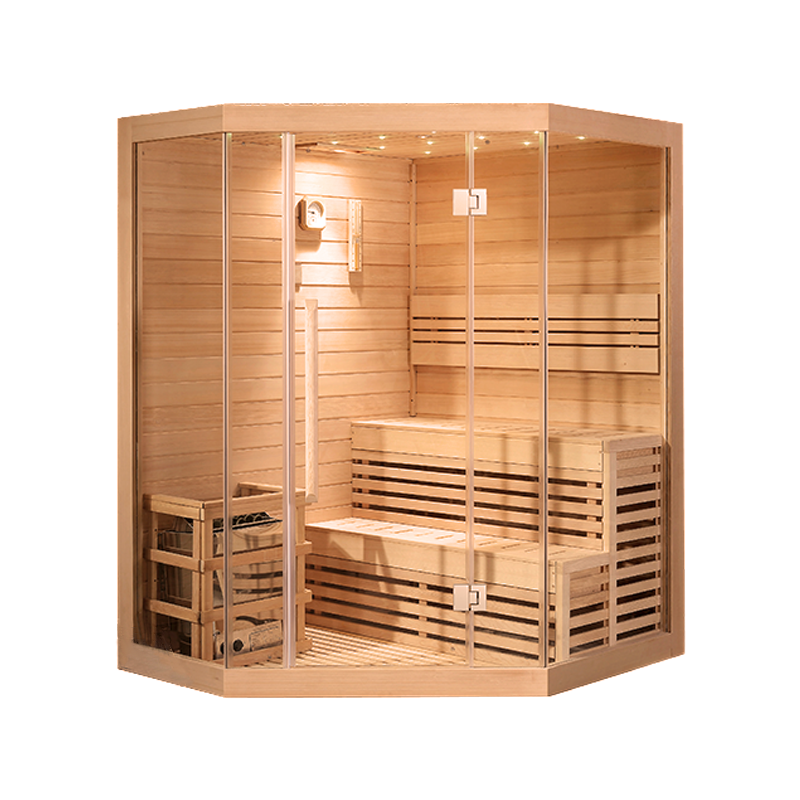Key Takeaways
-
Temperature & Comfort: Steam rooms deliver gentle 40-45°C humid heat ideal for respiratory health, while saunas provide intense 70-90°C dry heat for deep muscle recovery and cardiovascular benefits
-
Therapeutic Applications: Traditional saunas excel for athletic performance and detoxification through profuse sweating, while steam rooms superior for sinus relief, skin hydration, and gentle stress reduction
-
Beginner-Friendly: Infrared saunas offer most accessible introduction with moderate 50-60°C temperatures and longer comfortable sessions, compared to potentially overwhelming steam room humidity
-
Investment Considerations: Steam rooms require RM15,000-50,000+ for complex waterproofing installations, while infrared saunas provide more affordable RM8,000-25,000 options with simpler setup
-
Complete Recovery Systems: Warrior Plunge premium saunas offer seamless contrast therapy integration combining cardiovascular enhancement, muscle recovery, stress reduction, and mental resilience when paired with precision cold plunge systems for maximum wellness benefits
Introduction
Choosing between a steam room and sauna affects your recovery, wellness goals, and daily comfort. While both deliver heat therapy benefits, they work through different mechanisms—steam rooms use humid heat around 40-45°C, while saunas provide dry heat reaching 70-90°C.
This comprehensive comparison examines the science behind each option, helping you select the ideal heat therapy for muscle recovery, respiratory health, skin benefits, and stress relief. Whether you're an athlete optimizing performance or someone seeking wellness enhancement, understanding these differences ensures you invest in the right solution.
What Is a Steam Room?
Steam rooms generate therapeutic benefits through high humidity (nearly 100%) at moderate temperatures of 40-45°C (104-113°F). Steam generators heat water to create vapor that fills the enclosed space, creating a cloud-like environment that penetrates deeply into your respiratory system and skin.
How Steam Therapy Works
The high moisture content allows heat to transfer more efficiently to your body compared to dry environments. This humid heat opens airways, increases circulation, and promotes sweating at lower temperatures than traditional saunas. Your body responds by dilating blood vessels, increasing heart rate moderately, and activating natural detoxification processes.
Design and Installation
Steam rooms typically feature non-porous materials like ceramic tile, glass, or sealed stone to prevent moisture damage. Proper ventilation systems prevent mold growth, while sloped floors ensure drainage. Most residential units require steam generators, waterproofing, and specialized electrical connections.
The enclosed design traps moisture effectively, but requires more complex installation than many sauna options due to waterproofing requirements and humidity management systems.
While steam rooms offer unique benefits through humid heat, saunas take a dramatically different approach to heat therapy that delivers distinct advantages.
What Is a Sauna?
Saunas deliver therapeutic heat through dry air heated to 70-90°C (158-194°F) with humidity levels below 20%. This creates an intense but manageable environment that promotes deep sweating, cardiovascular benefits, and muscle recovery through different mechanisms than steam therapy.
Types of Saunas
-
Traditional Finnish saunas use heated rocks warmed by wood, gas, or electric heaters. Water poured over rocks creates brief humidity spikes while maintaining overall dry conditions.
-
Infrared saunas use electromagnetic radiation to heat your body directly at lower ambient temperatures of 50-60°C.
For detailed comparisons between sauna types, read our comprehensive guide on infrared vs traditional sauna benefits and differences.
How Sauna Heat Affects Your Body
Dry heat causes rapid surface sweating while penetrating deeper into muscle tissue. Your cardiovascular system responds similarly to moderate exercise—heart rate increases, blood vessels dilate, and circulation improves significantly. The heat shock proteins activated during sauna sessions support cellular repair and stress adaptation.
Now that we understand how each system works individually, let's examine the crucial differences that will determine which option best serves your wellness goals.
Key Differences Between Steam Rooms and Saunas

Firstly, let’s understand these fundamental differences to help you choose based on your specific health goals and comfort preferences:
Temperature and Humidity:
-
Steam rooms: 40-45°C with 100% humidity
-
Traditional saunas: 70-90°C with 10-20% humidity
-
Infrared saunas: 50-60°C with minimal humidity
Heat-Up Time:
-
Steam rooms: 5-10 minutes to reach optimal conditions
-
Traditional saunas: 30-45 minutes for full heat-up
-
Infrared saunas: 10-15 minutes using direct heating
These temperature and humidity differences directly impact how long you can comfortably remain in each environment.
How Humidity Affects Breathing and Comfort
High humidity in steam rooms can feel oppressive initially but helps individuals with respiratory conditions by moisturizing airways and loosening mucus. However, those with severe asthma may find the dense moisture challenging to breathe.
Dry sauna heat allows easier breathing for most users but can irritate sensitive respiratory systems. The low humidity environment feels less restrictive, making it easier to take deep breaths during sessions.
Session Duration and Comfort Levels
Is it easier to stay longer in a sauna or steam room?
Most users find saunas more comfortable for extended sessions despite higher temperatures. The dry heat allows better heat regulation through natural sweating, while steam rooms' humidity prevents effective cooling through perspiration.
Session Duration:
-
Steam rooms: 10-20 minutes due to intense humidity
-
Traditional saunas: 15-20 minutes in multiple cycles
-
Infrared saunas: 20-45 minutes at more tolerable temperatures
Which is more comfortable for beginners or sensitive users?
Steam rooms offer gentler introduction to heat therapy with lower temperatures, though humidity may feel overwhelming. Infrared saunas provide the most beginner-friendly experience with moderate temperatures and gradual heating that allows easy adaptation.
Understanding these fundamental differences sets the foundation for exploring how each system's unique characteristics translate into specific health benefits. Let's start with what makes steam rooms particularly effective for certain conditions.
What Are the Benefits of Steam Rooms?
Steam rooms excel in specific therapeutic areas due to their unique humid heat delivery:
Respiratory Health Enhancement
The moisture-rich environment helps liquefy mucus, clear sinuses, and ease breathing difficulties. Steam therapy proves particularly beneficial for individuals with asthma, allergies, or seasonal congestion, though those with severe respiratory conditions should consult healthcare providers first.
Beyond respiratory relief, steam rooms offer unique advantages for your body's largest organ—your skin.

Skin Hydration and Cleansing
Unlike dry saunas that can dehydrate skin, steam rooms provide moisture while opening pores for deep cleansing. The humid heat increases circulation to skin surface, promoting natural hydration and potentially improving conditions like eczema or dry skin.
Mental Health and Relaxation Benefits
Which is the best sauna for mental health or relaxation benefits?
Steam rooms create a cocoon-like environment that many find deeply calming. The enveloping moisture and moderate temperatures promote meditation and stress relief without the intensity that might overwhelm sensitive individuals.
The humid environment naturally slows breathing patterns, activating the parasympathetic nervous system more gently than high-heat saunas. This makes steam rooms particularly effective for anxiety reduction and mental decompression.
Gentle Muscle Recovery
The moderate temperatures combined with high humidity create effective muscle relaxation without the intensity of traditional saunas. This makes steam rooms suitable for daily use and gentle recovery protocols, though they provide less deep tissue penetration than high-heat saunas.
While steam rooms excel in respiratory and skin health, saunas deliver their own powerful set of benefits through intense dry heat that affects your body in distinctly different ways.
What Are the Benefits of Saunas?
Saunas deliver distinct advantages through their high-temperature, low-humidity environment:
Muscle Recovery and Athletic Performance
Which one is the best sauna for muscle recovery and athletic performance?
Traditional Finnish saunas excel for serious athletic recovery due to their high temperatures (70-90°C) that promote deep tissue heat penetration, enhanced blood flow, and heat shock protein activation.

The intense heat triggers physiological adaptations similar to moderate exercise, improving cardiovascular capacity and heat tolerance—valuable for athletic performance. Professional athletes often prefer traditional saunas for post-training recovery due to their superior muscle penetration and circulation enhancement.
These muscle recovery benefits extend beyond immediate relief to support your entire cardiovascular system.
Cardiovascular Health and Circulation
Research demonstrates that regular sauna use improves cardiovascular health markers, reduces blood pressure, and enhances circulation. The heat stress mimics moderate exercise, providing similar heart health benefits for those unable to engage in intense physical activity.
Sleep Quality and Stress Reduction
Which type of system is best for improving sleep quality or reducing stress?
Both systems improve sleep, but through different mechanisms. Saunas provide more dramatic temperature regulation benefits—the post-sauna cooling naturally triggers sleepiness by mimicking the body's natural circadian temperature drop.
Steam rooms offer gentler stress reduction through their meditative environment, making them better for individuals who find high heat overstimulating before bedtime. Evening steam sessions promote relaxation without the intense physiological arousal of high-heat saunas.
Deep Detoxification Through Sweating
The intense heat promotes profuse sweating, helping eliminate toxins through skin. While the body naturally detoxifies through liver and kidneys, sauna-induced sweating may support these processes and improve overall metabolic function.
Weight Management Support
Sauna sessions burn calories through increased heart rate and metabolic activity. While not a substitute for exercise and proper nutrition, regular sauna use may support weight management goals as part of a comprehensive wellness program.
Aromatherapy and Enhancement Options
Can I use scents or aromatherapy in steam and sauna rooms?
Both systems accommodate aromatherapy, but with different approaches:
Steam Rooms: Add essential oils directly to the steam generator or use wall-mounted dispensers. Eucalyptus, lavender, and peppermint prove most popular for respiratory and relaxation benefits. The humid environment disperses scents effectively throughout the space.
Saunas: Traditional saunas use essential oils mixed with water and poured over heated rocks. Birch, pine, and eucalyptus complement the authentic Finnish experience. Infrared saunas require aromatherapy diffusers since they lack heated rocks for oil application.
Always use high-quality, therapeutic-grade oils and avoid synthetic fragrances that may cause respiratory irritation in heated environments.
Despite these impressive benefits from both systems, responsible use requires understanding potential risks and safety considerations that apply to all forms of heat therapy.
What Are the Risks and Precautions for Steam Rooms and Saunas?
Both heat therapy methods require safety awareness and proper protocols:
Can children or elderly people safely use steam rooms or saunas?
Both populations require special considerations and modified protocols:
-
Children (Ages 12+): Can safely use both systems with adult supervision and reduced temperatures/duration. Start with 5-7 minute sessions at lower temperatures. Children under 12 should avoid heat therapy due to immature temperature regulation systems.
-
Elderly Users: Heat therapy offers significant benefits but requires medical clearance for those with cardiovascular conditions. Shorter sessions (8-12 minutes), lower temperatures, and constant hydration prove essential. The gradual heating of infrared saunas often works best for seniors.
Who Should Exercise Caution:
Individuals with cardiovascular disease, uncontrolled hypertension, pregnancy, or certain medications should consult healthcare providers before beginning heat therapy. Those with diabetes, kidney disease, or circulation disorders require medical clearance.
Common Risk Factors
-
Dehydration poses the primary risk in both environments. Proper hydration before, during, and after sessions prevents complications.
-
Overheating can occur when exceeding recommended time limits or ignoring body signals.
-
Respiratory irritation may affect sensitive individuals, particularly in steam rooms where humidity can trigger breathing difficulties in those with asthma or chronic respiratory conditions.
Safe Usage Guidelines
-
Limit initial sessions to 5-10 minutes
-
Maintain proper hydration with 16-20 ounces of water per session
-
Never use alone—have someone aware of your session timing
-
Exit immediately if experiencing dizziness, nausea, or breathing difficulties
-
Allow cooling periods between multiple sessions
Armed with knowledge of both benefits and risks, you can now make an informed decision based on your specific needs, preferences, and circumstances.
How to Choose Between a Steam Room and Sauna?
Your decision should align with specific health goals, practical considerations, and personal preferences:
Based on Health Goals
Choose steam rooms for:
-
Respiratory support and sinus relief
-
Gentle skin hydration and pore cleansing
-
Moderate heat therapy introduction
-
Daily stress relief without intense heat
-
Individuals sensitive to high temperatures
Choose saunas for:
-
Maximum muscle recovery and athletic performance
-
Cardiovascular health improvement
-
Deep tissue heat penetration
-
Weight management support
-
Sleep quality enhancement through temperature regulation
While health goals provide the primary decision framework, practical factors often determine what's actually feasible for your situation.
Practical Considerations
-
Space and Installation: Steam rooms require extensive waterproofing and ventilation systems. Saunas, particularly infrared models, offer easier installation with standard electrical requirements.
-
Maintenance Requirements: Steam rooms need regular cleaning to prevent mold and mineral buildup. Saunas require minimal maintenance beyond occasional cleaning and heating element inspection.
-
Energy Costs: Steam generators consume significant energy during operation. Infrared saunas prove most energy-efficient, while traditional saunas use moderate electricity or other fuel sources.
Combining with Other Therapies
Can either system be used simultaneously with other therapies like cold plunges or contrast therapy?
Both steam rooms and saunas integrate excellently with cold exposure protocols for enhanced recovery benefits.
Contrast therapy—alternating between heat exposure and cold plunge immersion—maximizes circulation benefits and adaptation responses. The temperature differential between saunas and cold plunges creates more dramatic vascular responses, while steam rooms offer gentler contrast therapy introduction.
Warrior Plunge's contrast therapy systems integrate seamlessly with cold plunge tubs for comprehensive recovery protocols that combine the benefits of both heat and cold therapy.
Frequently Asked Questions On Choosing And Using Heat Therapy Systems
How often should I use heat therapy for optimal results?
3-4 sessions per week provide optimal benefits for most users. Daily use is acceptable for experienced individuals who tolerate heat therapy well.
Is heat therapy effective after workouts?
Both steam rooms and saunas support post-workout recovery, though timing matters. Wait 30-60 minutes after intense exercise to allow natural cooling before heat exposure.
Can heat therapy help with weight loss?
While not a primary weight loss method, regular heat therapy may support metabolism and calorie burning when combined with proper diet and exercise.
What is the typical price range for steam rooms vs saunas?
Steam rooms cost RM15,000-50,000+ due to complex waterproofing and ventilation requirements. Steam rooms typically have higher operating costs than infrared saunas.
Warrior Traditional Saunas range from RM15,000 onwards (with customisation), while Warrior Portable Steam Sauna units start from RM1,500 onwards.
After weighing all these factors—from health benefits to installation requirements—you're ready to make an informed choice between steam rooms and saunas.
Conclusion: Steam Room vs Sauna — Which One Fits Your Lifestyle?
Your choice between steam rooms and saunas depends on individual goals, comfort preferences, and practical considerations. Steam rooms excel for respiratory health, gentle skin care, and moderate heat therapy introduction—particularly beneficial for beginners or those seeking mental relaxation without intense heat.
Warrior Saunas provide superior muscle recovery, cardiovascular benefits, and athletic performance enhancement through their high-temperature environment. Traditional saunas offer maximum therapeutic intensity, while infrared models provide gentler heat for daily use.
Consider experiencing both options at wellness facilities before choosing. For home installations, evaluate your space, maintenance capabilities, and wellness objectives. Transform your recovery with Warrior Plunge's complete collection of precision-controlled cold therapy systems and professional-grade saunas for scientifically-proven contrast therapy protocols.
Ready to design your ideal recovery system? Contact us today for personalized guidance on creating the perfect heat and cold therapy setup for your needs.
Read more

Discover the optimal ice bath temperature (10-15°C) for recovery. Complete guide covers duration, safety, and protocols for beginners to athletes.

Sauna therapy benefits for men & women: weight loss, recovery, hormonal balance & mental wellness. Read how to choose the right sauna type for health goal





